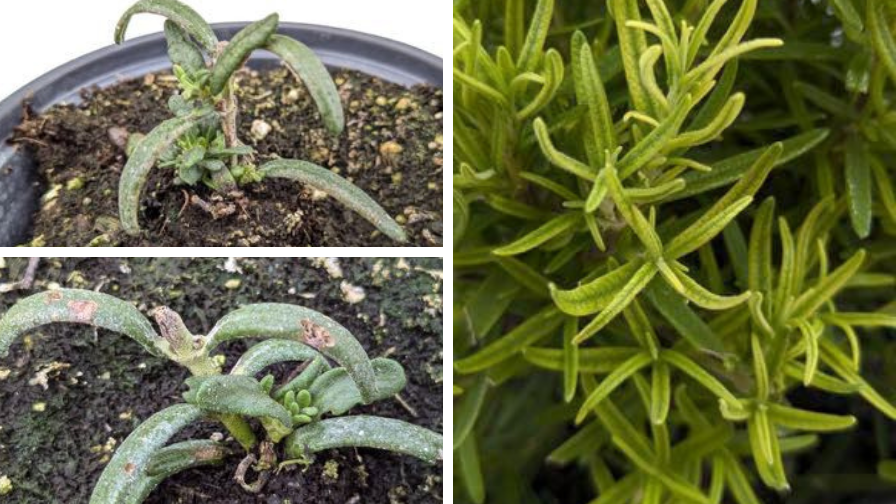
Rosemary with boron (L) and iron (R) problems | Brian Whipker
Brian E. Whipker and Patrick Veazie of North Carolina State University recently examined a batch of holdover rosemary plants from the spring in a pair of recent e-Gro alerts. While the vast majority of the crop was fine, a few examples exhibited boron and iron deficiencies. So, how were these problems spotted, and what can be done to remedy the nutrient deficiency issues?
Rosemary – Brittle and Distorted Leaves
Typical symptoms of a boron deficiency in the rosemary plants were present, such as new leaves that were small, distorted, and brittle. Despite having been initially trimmed when the leaves got too large, they did not grow back and “resume normal axillary shoot development,” instead having their growth stalled.
Boron Deficiency in Rosemary
The role of boron in plants is similar to that of calcium, in that the nutrient is “transported by plants via mass flow,” with the primary transportation method being water uptake through transpiration. Therefore, certain plant injuries or environmental conditions that inhibit or lessen the amount of water uptake also limit the amount of boron a plant takes in.
Management and Solutions for Rosemary Boron Deficiency
There are no corrective procedures available in the case of affected plants. They simply must be discarded. However, to avoid the onset of boron deficiency in rosemary and other plants, make sure that boron is included in the plant’s fertility program, that there isn’t an issue of over-irrigation, and that nothing is affecting the plant’s water transpiration mechanism.
Rosemary – Yellowing Leaves
Interveinal chlorosis, a condition that causes the yellowing of plant tissue, is a common symptom and indicator of iron deficiency.
Iron Deficiency in Rosemary
The handful of rosemary plants that Whipker and Veazie identified with iron problems were all being grown with the aid of a drip irrigation nozzle. In contrast to the problems of lacking boron stemming from a lack of water absorption, this problem of iron deficiency is due to a case of excessive moisture limiting iron uptake.
Additionally, the pair notes that “a dose of limestone had been added to the top of the pot.” Due to the presence of extra moisture, the available limestone was more readily available to modify the substrate pH, raising it to 6.6. This elevated substrate pH of the rosemary plants is likely a contributing factor to the onset of interveinal chlorosis.
Management and Solutions for Rosemary Iron Deficiency
The excess moisture is the main problem that contributes to these iron problems in rosemary. Therefore, the most important steps are preventing an overly saturated substrate for the plant, as well as giving it the ability and opportunity to effectively dry out between scheduled irrigation intervals. If these don’t help return the color green to the plant, Whipker and Veazie recommend an iron chelate application as an additional measure.
For more information regarding the cause and solutions to nutrient deficiencies in zinnias, please read the full e-Gro (Electronic Grower Resources Online) alerts “It’s Complicated: Rosemary Boron Problems,” and “It’s Obviously an Iron Problem, But Why?” Additional and current e-Gro alert pieces from Volume 13 (2024) can be found online.
0
1
5
How to Identify Boron and Iron Problems in Rosemary

